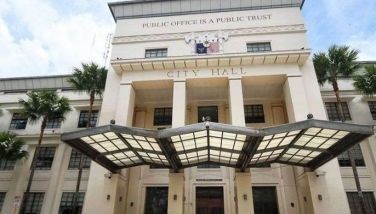Cebu’s need in two years: ‘Reliable power’

CEBU, Philippines — Cebu remains to have a stable power supply in the next two years but it needs more power plants to make it reliable and sustainable.
This, as Cebu Governor Gwen Garcia emphasized the vital role of reliable power in driving the province’s economic development, in a message during The Freeman Business Forum’s “Powering Cebu” yesterday.
“We are safe, at least for the time being. The power demand in Cebu year on year is exceeding than the national average. If we are to even be able to match the phenomenal growth that Cebu is experiencing right now, we would have to be serious in generating more (power) capacity. That has become a focus and priority for me,” she said, addressing the over a hundred participants comprising energy stakeholders, local government officials, and industry leaders.
The governor said “power is a crucial and non-negotiable ingredient to progress.”
“If water is life, as we often heard, or kilay is life, but then power gives life to the economy. If there is lack of power, then, there is no economic growth to speak of,” she said, in emphasizing the importance of reliable and sustainable energy sources in fostering growth across all economic sectors.
“Power gives light to the economy,” she further said, echoing the “profound impact energy has on business, industry, and the daily lives of Cebuanos.”
The governor's remarks came as Cebu province embarks on a “groundbreaking energy initiative—a partnership with global energy company Acciona Energia for the development of a 150-megawatt solar power plant in Daanbantayan.”
“The project marks a significant milestone for Cebu, as it takes steps toward securing a cleaner and more sustainable energy future, while simultaneously boosting its energy capacity to support the growing demands of its economy,” the governor said.
The solar power plant is expected to “significantly reduce the province’s reliance on traditional energy sources, providing a steady and renewable supply of power to communities and industries alike”.
The project is also expected to create hundreds of jobs during its construction phase, with long-term benefits for both local businesses and residents.
Garcia described the solar power venture as not only a key to Cebu’s energy security but also a “crucial component of the province's commitment to environmental sustainability”.
She urged stakeholders to embrace the opportunities in renewable energy and to “work together in building a resilient, energy-secure future for Cebu.”
With power being a “key pillar of economic development”, she stressed the “need for continued investment in infrastructure that would allow the province to thrive in an increasingly energy-conscious world.”
More power plants
Department of Energy Assistant Secretary Mario Marasigan, on the other hand, said in the same forum that Cebu is growing fast so it needs more power plants.
“Sa ngayon…there is no problem with transmission and power supply within the next two years. However, if we want to have a reliable, sufficiently-produced (power), independently for the Visayas, then we have to come up with new generation facility projects,” he said.
Neil Modina, OIC - National Grid Corporation of the Philippines, Visayas System Operations assistant vice president, who spoke on “Transmission: Ensuring Grid Reliability and Security,” said Cebu’s total power capacity is 1,123 megawatts, while its peak demand is at 1,223 megawatts, or a negative reserve of 100 megawatts.
But because of the interconnection of the Luzon, Visayas, and Mindanao power grids, Cebu, through the “Import Power Transfer Capacity”, has 450 megawatts available from Mindanao and 250 megawatts from Luzon.
Marasigan explained that to prevent a one day or one-hour outage, the Visayas grid needs an additional capacity of 600 megawatts.
“Ang transfer capacity nang Luzon is 250 megawatts and Mindanao is 450 megawatts, which means the total is 700 megawatts. So, may excess pa siya na 100 megawatts,” he said.
“For Visayas to be independently stable yung power supply, we need more generation facilities here. Not necessarily in Cebu but in the Visayas, so long as connected siya (Cebu) sa Visayas grid,” he added.
Marasigan also explained that Cebu serves as the connection hub for the entire Visayas.
“Our interconnection from Mindanao as well as the flow of energy in Luzon passes through Cebu before we can serve other islands,” he said.
Marasigan said that with the completion of the transmission facility projects of NGCP, “we should be able to realize a reliable and robust transmission facilities or conveyance of supply to our demand.”
“This now entails that aside from providing the needed power supply, that is required for our increased demand, then we have to make sure that our transmission facilities should be able to cater to the transfer of energy not only for Visayas but within the Visayan islands,” he said.
NGCP has now an ongoing Visayas Substation Upgrading Project (VSUP), which includes Cebu’s Danao City, Daanbantayan, Balamban, Compostela, Samboan, City of Naga, Lapu-Lapu City, and Mandaue City.
It also has future projects like the Pusok-Cordova 230KV Interconnection Project; Laray-Cordova 230KV Interconnection Project; Laray-San Fernando 230KV Energization Project; San Fernando 230KV Substaion Project; and the Cebu-Negros 230KV Interconnection Lines 3 and 4 Project.
Modina said the upgrading of the 230KV interconnection project “aims to provide support the entry of power plants and forming 230KV transmission loop is aim to provide resiliency and reliability to customers in Metro Cebu”.
NGCP’s completed projects this year includes the Cebu-Negros-Panay 230 KV Backbone Project, Permanent Restoration kf the Colon-Samboan 138KV Lines 1 and 2.
Crucial in sustaining growth
In the same forum, Miguel Belmonte, Philstar Media Group president and chief executive officer, spoke about the purpose of the activity, which is meant to tackle an “essential aspect of Cebu's progress,” among industry stakeholders.
“We are very fortunate to have with us today a number of key players in the power sector who will help us gain a better appreciation of the energy situation in Cebu, as well as initiatives to address power supply challenges in the region,” Belmonte said.
He said that energy will be “very crucial in sustaining the growth - momentum of the Central Visayas region, which last year was the country's fastest-growing regional economy.”
“This could only mean one thing for the energy sector: higher demand. Something I picked up from a forum that Aboitiz Power organized for media professionals in Cebu just last week is that based on Department of Energy estimates, peak demand in Cebu is projected to double by 2032 compared to the present. Fact is, we are really racing against time to support and sustain Cebu's impressive economic performance,” said Belmonte.
He said that Cebu province alone already corners half of the total energy demand in Central Visayas, while Metro Cebu accounts for more than half of the province-wide demand.
This, he said, puts a lot of pressure on the regional grid to keep supplying energy for Cebu's growing needs.
Besides emphasizing the urgency of addressing power supply concerns to ensure Cebu's economic growth, through this forum, Belmonte said they are also “looking to initiate relevant discussions on the policy and regulatory support that would align with growth in the region; innovative solutions to address Cebu's energy challenges/and opportunities for partnership and investment that would accelerate power infrastructure development.”
He said that “even more vital to the discussion” is the “need to pursue alternative and renewable energy sources that would not only support Cebu's economic growth but, more importantly, ensure its sustainable future”.
“The stakes are high. Economic prosperity can only happen if Cebu is able to attain energy security,” Belmonte said.
Digitalizing distribution
In the same forum, Visayan Electric (VECO) president Raul Lucero talked about “Digitalizing Distribution: Modernizing Networks for Enhanced Reliability and Customer Experience” and discussed the features of their mobile app, wherein their customer can view their monthly consumption and bills, pay the bills online, and view current power outages, among others.
By next year, he said, VECO will introduce additional features, like “online application for new customers, appointment booking, report power interruptions or accidents, and submit inquiries.
“Our goal is to provide a convenient, user-friendly platform that empowers you to make informed choices about your energy consumption and communicate with us. Whether you're identifying usage trends or making seamless payments, MobileAP is designed to simplify your experience as a customer,” Lucero said.
Aboitiz Power-Thermal Business Group Chief Engineer Rolando J. Paulino, Jr. on the other hand, underscored the need for a “balanced energy mix to support Cebu’s rapid growth and ensure a sustainable, accessible, and affordable power supply in the region”.
He said the Philippines faces an “energy burden” where minimum-wage earners allocate a significant portion of their income for electricity, which is a larger burden than when living in countries like Singapore, where wages are higher relative to energy costs.
“The problem is the salaries of the Filipinos are much lower. And therefore, the burden to us. It's actually much higher,” he further said.
Paulino emphasized that transitioning to renewable energy, while necessary for sustainability and climate goals, raises questions about affordability, noting that “moving away from coal in favor of LNG (Liquefied Natural Gas), for example, would increase electricity costs by around 400 pesos per month for households consuming 200 kilowatt hours”.
This, he said, is a considerable portion of the minimum wage earner’s monthly income. There is, therefore the need for “careful planning in renewable energy adoption to avoid unaffordable price hikes”.
Paulino said that while renewables offer promising opportunities, there are limitations of the Visayas grid in fully absorbing large-scale renewable inputs.
“What we want to do is really shape an energy system, the power's progress, while being mindful of the needs and helping attain the fullest potential of people in our businesses,” he said.
“Let's move forward with purpose and determination working together to build an energy future that truly benefits everyone,” he added.
Artificial intelligence level
On the other hand, ACCIONA ENERGIA Country Manager Fermin Alvarez said that the system in the Philippines has not been upgraded, especially in many provinces, so the possible solutions are to make the grid” digitized, smarticized, and must be reached at the Artificial Intelligence level.”
He said promoted the “greening” of the grid through renewables such as coals, solar, wind and others. He said that technologies for these can be implemented in a more cost-effective and quick way.
For instance, Alvarez said, the solar plant can be done in two years only while the wind farm would be ready in three to four years only.
“We frequently ran out and also system losses. There's a lot of inefficiency in the local grids on how the energy is delivered,” he said.
He said that “with energy demand continuing to rise, finding a balance between reliable supply and greener energy sources has become crucial”.
Alvarez explained that traditional energy sources like coal and natural gas have long provided this reliability, but environmental impacts have raised concerns, and renewable sources, such as wind and solar, offer cleaner alternatives but are often intermittent, depending on factors like weather.
Therefore, he said, the solution lies in developing a power mix that integrates both “stable base-load generation with clean, renewable sources to provide consistent supply without compromising sustainability”.
“I think that's the great challenge here, like how we do something that makes sense in which the supply is steady. We have a solid base load and at the same time we start to change in the way this country generates supply,” Alvarez said.
The Freeman’s Business Forum was sponsored by Globaltronics, San Miguel Corporation, Topline, Vivant, Carmen Copper Corporation, Globe, Seda Hotel, Twinbee, Light Fuels, Sto. Nino. Mactan College Inc., Heritage Productions, and Global Business Power. — /RHM (FREEMAN)
- Latest
























